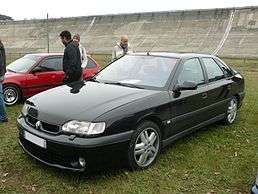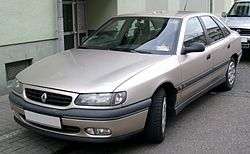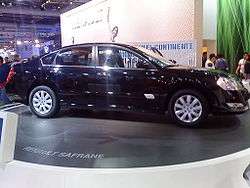Renault Safrane
| Renault Safrane | |
|---|---|
|
| |
| Overview | |
| Manufacturer | Renault |
| Production | 1992–2000 |
| Body and chassis | |
| Class | Executive car (E) |
| Body style | 5-door liftback |
| Layout | Front engine, front-wheel drive / four-wheel drive |
| Dimensions | |
| Wheelbase | 2,765 mm (108.86 in) |
| Length | 4,768 mm (187.72 in) |
| Width | 1,816 mm (71.50 in) |
| Height | 1,435 mm (56.50 in) |
| Chronology | |
| Predecessor | Renault 25 |
| Successor | Renault Vel Satis |
The Renault Safrane was an executive car (E-segment in Europe) designed and built by the French manufacturer Renault from 1992 to 2000. Throughout its lifespan it remained the most expensive and most luxurious Renault available, although its commercial success was limited, compared to some similar models. It was replaced by the Vel Satis, and to some extent, by the short lived two-door Avantime.
Since 2008, a new model, based directly on the Renault Samsung SM5 sedan, is also called Renault Safrane.
Background
The Safrane was launched in April 1992, to replace the ageing Renault 25 in the full-size market segment. Its clean, aerodynamic styling was quite conservative and very typical of early 1990s car design, also quite reminiscent of the 25's.
All Safranes were 5-door liftbacks with transversely mounted engines. Front-wheel drive and four-wheel drive versions were available, with a range of petrol or diesel engines and manual or automatic transmissions. All petrol engines were fuel-injected and were fitted with three-way catalytic converters, as required in Europe after 1993 for engines of all sizes. The Safrane was also the first Renault to be equipped with air bags.
History
The Safrane carried over the Renault 25's 5-door hatchback design that had gained wide customer acceptance in France. Despite the traditional preference for saloon bodies in the executive car segment, Renault decided to compete on the base of added practicality of the rear door and split-folding rear seat (not available from most sedan-bodied competitors), as well as originality.
Given the preference for German saloons from Audi, BMW and Mercedes-Benz of many executive car buyers, this can be viewed as good marketing tactics, allowing Renault to draw the buyers looking for alternatives, rather than compete head-on. The series 2 Safrane featured slightly (but visibly) different front ends in different versions, in an attempt to emphasize the unique status of more upmarket models, although these treatments differed in different markets.
The Safrane's design was a deliberate effort to overcome the R25's main weaknesses — insufficient chassis stiffness and poor build quality. Renault was also keen to take noise reduction to best-in-class levels. These constraints resulted in a much heavier car than its predecessor (+200–300 kg / 440-660 lb.) due to a heavily reinforced chassis and the liberal use of sound-proofing materials.
At launch in 1992, the Safrane offered six engines including one diesel (all gasoline motors have a catalytic converter) :
Gasoline:
- 2.0 L (1995 cc), J7R-Q732/Q733, injection, 8v I4, 107 PS (79 kW; 106 hp) (in markets where engine size was a factor in yearly registration costs)
- 2.2 L (2165 cc), J7T-R760/S761, injection, 8v Douvrin I4, 107 PS (79 kW; 106 hp) (in other markets)
- 2.0 L (1995 cc), J7R, injection, 12v I4, 133 PS (98 kW; 131 hp) (in markets where engines above 2.0 L are heavily taxed)
- 2.2 L (2165 cc), J7T, injection, 12v Douvrin I4, 137 PS (101 kW; 135 hp) (in other markets)
- 3.0 L (2963 cc), Z7X-B722/B723/P722/P726/C723/B753, injection, 12v PRV V6, 167 PS (123 kW; 165 hp)
Diesel:
- 2.1 L (2068 cc), J8S-T760, 8v I4 Turbodiesel, 88 PS (65 kW; 87 hp)
- 2.5 L (2499 cc), S8U-L762/M763, 8v I4 IVECO-SOFIM S8U/8144.97 Turbodiesel, 113 PS (83 kW; 111 hp)
The Safrane's launch was free of the build quality problems that ruined the Renault 25's reputation. Critics praised the car's comfortable and spacious interior, excellent noise insulation, and incisive handling. However, the manual transmission's cable-actuated shifter (a first on a Renault) drew heavy criticism for its rubbery, uncommunicative feeling that spoiled the driving experience — a significant issue in the European market where more than 80% of cars sold are manuals.
Critics would also conclude that the car's acceleration and fuel economy was not up to the competition's standards, pointing out towards the engine's relative lack of power and torque compared to the vehicle's weight. As a result, sales outside France (where national preference guaranteed good results) remained limited, and the Safrane did not break the Germans' lock on the executive car market.
In late 1993, a 115 PS 2.5 L turbodiesel was added to the range, increasing Safrane's attractiveness, yet it faced tough competition from the likes of Audi's 140 PS (103 kW; 138 hp) direct-injection diesel of the same size, introduced a few months later in the Audi 100.
The Renault Safrane was considered the most frequently used official car of former President of France, Jacques Chirac.
Safrane Biturbo

In 1994, Renault launched the high-performance Biturbo version available in RXE and Baccara models. This model featured a twin-turbo, 262 PS (193 kW; 258 hp) evolution of the 3.0 L V6 of the Alpine A610, developed with the assistance of German tuning firms Hartge and Irmscher, coupled with all wheel drive. However, it was only available with a manual transmission, as no automatic gearbox existed anywhere in the world for a transversely mounted engine of that horsepower with AWD.
Given that automatic transmissions and V8 engines are strongly preferred in the price class where Biturbo competed, it is not surprising that only 806 Biturbos were made. Production ended in September 1996. In the same year, the French coachbuilder Heuliez presented the Safrane Long Cours, which was something like a station wagon version of the Safrane Biturbo in luxury Baccara trim.
Facelift

Renault gave the Safrane a major upgrade in July 1996, in order to revive sales. The front and rear ends of the car were restyled in a much more modern fashion and the equipment levels upgraded. The concept that every trim level got a slightly different front end was retained.
A redesign of the manual transmission's cable actuator solved the shift-quality issue, while a new Aisin Warner automatic transmission replaced the somewhat unreliable Renault unit which was well known to dump its transmission fluid on the road generally without prior warning. The series I automatics are probably therefore best avoided second hand.
The engine lineup was completely renewed:
Gasoline:
- 2.0 L (1948 cc), N7Q, 16v Volvo B420 I4, 136 PS (100 kW; 134 hp)
- 2.5 L (2435 cc), N7U, 20v Volvo B524 I5, 165 PS (121 kW; 163 hp)
- 3.0 L (2946 cc), L7X, 24v Renault L V6, 190 PS (140 kW; 187 hp)
Diesel:
- 2.2 L (2188 cc), G8T, 12v I4 Turbodiesel, 113 PS (83 kW; 111 hp)
The 4- and 5-cylinder petrol engines were a Volvo design and their inclusion in the Safrane lineup was a result of Renault's short-lived alliance with the Swedish carmaker in the early 1990s (the B41 was also fitted in the Laguna). The V6 was an all-new PSA-Renault design and drew wide praise for its abundant low- and mid-range torque, even if the Germans offered 10-20 bhp more out of the same displacement. The turbodiesel was an all-new in-house design.
However, while the Volvo engine designs would externally appear to be a domestic Volvo, there are minor differences. The engine mounts are one example along with the oil filter mounting, power steering pump, ECU, timing belt cover and probably the gearbox setup. The camshaft pulleys were inverted by Renault making the Volvo timing marks redundant. The engine must now utilise a specialist alignment tool to set up the timing however this tool can also be used on the same genuine volvo engines. The 2.5 engine is really a 2.4 being 2435cc but was rounded up by Renault.

The modernisation did not bring about a significant breakthrough in sales results, and the model was finally discontinued in December 2000, having sold less than the Renault 25 it had replaced. For 2001, it was replaced by the much more radically styled Vel Satis, accompanied by the original "tall 2-door" Avantime. The Vel Satis did not fare too well either, while the Avantime's design didn't find widespread acceptance in the marketplace and the model was quickly discontinued. In the United Kingdom, while liked by critics and reviewers the buying public stayed away in droves.
Finishes
- Petrol
- 2.0 RN
- 2.0 RT
- 2.0 RXE
- 2.0i RTE
- 2.0i RXE
- 2.0i RXT
- 2.2si RN
- 2.2si RT
- 2.2si RXE
- 2.2si PALME D'OR
- 2.5i RXE
- 2.5i RTE
- 2.5i INITIALE
- V6i RT
- V6i RXE
- V6i RXE QUADRA
- BITURBO BACCARA
- V6 RXE
- V6 RXT
- V6 INITIALE
- V6 BACCARA
- Diesel
- 2.1dt RN
- 2.1dt RT
- 2.2dt RTE
- 2.2dt RXE
- 2.2dt RXT
- 2.5dt RN
- 2.5dt RT
- 2.5dt RXE
Trim levels
RN
Lowest trim level. Available Engines: 2.1 dT 2.5dT, 2.0i, 2.2Si. Externally: the mirrors are painted body colour and the vehicle receives hubcaps simple design:
Inside: 2 electric windows, electric mirrors (few models manuals mirrors!). This trim level offers all the same management, remote central Reverse Lock (infrared). The upholstery fabric, the less cosy than the upper armrest release. Lack of air conditioning, dual zone heating series.
RT
Intermediate level of finish. Available Engines: 2.1 dT 2.5dT, 2.0i, V6. Externally: the mirrors are black, but so-called "honeycomb" wheels are emerging. (Wheels Elysée ).
Inside: addition to power windows and mirrors, alarm appear (presence of volumetric sensors ceiling), a lock on the glove box, a velvet armrest, dual-zone automatic air conditioning (optional), the headphone jacks on the rear with a switch acting on the rear speakers, and speech synthesis. The Safrane RT are provided inside velvet "Trocadero".
RXE
Premium level of finish. Available Engines: 2.5dT Safrane RXE and V6.
At this stage there was: power steering, electric mirrors, 4 electric windows, rear headphone jacks, front seats with electrically adjustable velor seat and back, inflatable, heated, with memory for three different positions . Optional leather widely chosen by customers. mirror indexed reverse; dual zone air conditioning, rear leather electric seats (available till mid-1995) Pneumatic controlled suspensions, Hi-Fi Philips; speech; Wheels Image Double digital display (consumption, remaining range ...)
| RN | RT | RXE | ||
|---|---|---|---|---|
| alloy wheels | O | X | X | |
| fog lamps | O | O | ? | |
| electric and heated mirrors | O | X | X | |
| driver airbag | O | O | ? | |
| ABS | O | X | X | |
| Radio k7 6000 | O | O | X | |
| speech synthesis | No | X | X | |
| onboard computer | No | X | X | |
| leather | O | O | O | |
| rear electric windows | No | O | X | |
| two spots in rear seats | No | X | X | |
| floor lights | No | X | X | |
| electric glass sunroof | O | O | ? | |
| climate control | O | O | X | |
| Heated seats | No | O | X | |
| power seats | No | O | X | |
| Rear head restraints | O | X | X | |
| BVA on 2.5 dT | - | O | ? | |
| BVA on 2.0i | O | - | - | |
| If BVA on 2.2 | - | O | - |
Questor
Along with the Phase 2 Safrane, Renault also offered a Safrane variant called the Questor which also relied on the Volvo powerplants mentioned above. The Questor differs only by having a factory fitted satellite navigation which is a Phillips Carin 520 with infra-red remote control. This model was also fitted, at least in the United Kingdom market, with all the options available on the car as standard except the heated windscreen which was still an option.
2008

In 2008, Renault revived the Safrane name for several markets in the Gulf States.
Based directly on the second generation (A34R) of Renault Samsung SM5 sedan, the car was manufactured by Renault Samsung in South Korea, and also presented in Mexico in 2009.[3]
Renault now sells the Renault Latitude in Europe, although not in the United Kingdom. This is a lengthened and widened version of the Laguna, platform with vastly similar engines. In Mexico and the Persian Gulf States, the new Latitude is now sold as the Safrane.[4]
References
| Wikimedia Commons has media related to Renault Safrane. |
- ↑ "Les Renault séries spéciales.". aebergon.perso.neuf.fr. Retrieved 2016-07-17.
- ↑ "site d'informations sur la renault safrane: motorisations, finitions, sellerie, biturbo, initiale, volvo, baccara,v6, palme d or,". webdesigner34.perso.sfr.fr. Retrieved 2016-07-17.
- ↑ "New 2009 Renault Safrane ?!". Autoworld. 2008-08-26. Retrieved 2008-10-19.
- ↑ "Renault Safrane". Renault México. Retrieved 2011-09-28.
| « previous — Renault vehicles timeline 1980 to date, Western European and North American market | ||||||||||||||||||||||||||||||||||||||||||||
|---|---|---|---|---|---|---|---|---|---|---|---|---|---|---|---|---|---|---|---|---|---|---|---|---|---|---|---|---|---|---|---|---|---|---|---|---|---|---|---|---|---|---|---|---|
| Type | 1980s | 1990s | 2000s | 2010s | ||||||||||||||||||||||||||||||||||||||||
| 0 | 1 | 2 | 3 | 4 | 5 | 6 | 7 | 8 | 9 | 0 | 1 | 2 | 3 | 4 | 5 | 6 | 7 | 8 | 9 | 0 | 1 | 2 | 3 | 4 | 5 | 6 | 7 | 8 | 9 | 0 | 1 | 2 | 3 | 4 | 5 | 6 | ||||||||
| City car | 4 | Twingo I | Twingo II | Twingo III | ||||||||||||||||||||||||||||||||||||||||
| Twizy | ||||||||||||||||||||||||||||||||||||||||||||
| Supermini | 5 / 7 | Super 5 | Clio Symbol | Symbol II | ||||||||||||||||||||||||||||||||||||||||
| Clio I | Clio II | Clio III | Clio IV | |||||||||||||||||||||||||||||||||||||||||
| Zoe | ||||||||||||||||||||||||||||||||||||||||||||
| Small family car | 14 | 9 / 11 | 19 | Fluence | ||||||||||||||||||||||||||||||||||||||||
| Alliance / Encore | Mégane I | Mégane II | Mégane III | Mégane IV | ||||||||||||||||||||||||||||||||||||||||
| Large family car | 18 | 21 / Medallion | Laguna I | Laguna II | Laguna III | Talisman | ||||||||||||||||||||||||||||||||||||||
| Executive car | 20 / 30 | 25 | Safrane | Vel Satis | Latitude | |||||||||||||||||||||||||||||||||||||||
| Coupé | Fuego | Avantime | Laguna Coupé | |||||||||||||||||||||||||||||||||||||||||
| Roadster | Spider | Wind | ||||||||||||||||||||||||||||||||||||||||||
| Crossover SUV | Captur | |||||||||||||||||||||||||||||||||||||||||||
| Koleos | ||||||||||||||||||||||||||||||||||||||||||||
| Kadjar | ||||||||||||||||||||||||||||||||||||||||||||
| Mini MPV | Modus | |||||||||||||||||||||||||||||||||||||||||||
| Compact MPV | Scénic I | Scénic II | Scénic III | |||||||||||||||||||||||||||||||||||||||||
| Large MPV/CUV | Espace I | Espace II | Espace III | Espace IV | Espace V | |||||||||||||||||||||||||||||||||||||||
| LAV | Express | Kangoo I | Kangoo II | |||||||||||||||||||||||||||||||||||||||||
| Van | Trafic I | Trafic II | Trafic III | |||||||||||||||||||||||||||||||||||||||||
| Master I | Master II | Master III | ||||||||||||||||||||||||||||||||||||||||||